春 (2月末)
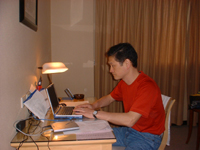
今度は新竹です (2月中旬)
台中での仕事が2月初旬で終わりました。次の現場は新竹(しんちゅう)という所になりました。 ここは、台北の南、車で一時間位に位置します。この現場は半導体工場(PSCというメーカー) で前回に比べると機械類も小さくなりましたが、クリーンルーム内の仕事という面では同じです。
今度は、ここ新竹の事を掲載してみたいと思います。
This time it’s Hsinchu (mid-February) My work in Taichung ended in early February. The next site was a place called Hsinchu. This place is located south of Taipei, about an hour’s drive. This site is a semiconductor factory (made by a manufacturer called PSC) and the machinery is smaller compared to last time, but the work inside the clean room is the same. Next time, I would like to post about Hsinchu.
暖房 (2月中旬)
台湾で暖房なんて、ちょっと変ですが、私の場合は必要です。台中のホテルでは冷房のみで、暖房 設備自体が無い状態でした。無い物ねだりしてもしょうがないのでベッドに潜り込んでテレビを 見ていましたが、ここ新竹は台中より北に位置するので、確実に寒いです。2月17日にここに来て 雨続き気温もかなり下がってます。ホテルに寒いので何とかしてと頼んだら、部屋の空調から暖かい 風が出始めました。そうです、ここは暖房が在るのです。助かったぁ。車に乗っても暖かいですし、 暖房の頻度が高いのでしょうね。台中は冬でも車は冷房を入れます。理由を聞いたら、窓が曇るから だと言うことでした。
Heating (mid-February) Heating in Taiwan is a bit strange, but in my case it’s necessary. The hotel in Taichung had only air conditioning and no heating equipment. There was no point in begging for something I didn’t have, so I crawled into bed and watched TV, but since Hsinchu is located north of Taichung, it’s definitely cold. I came here on February 17th and it was raining continuously and the temperature had dropped considerably. When I asked the hotel to do something about the cold, the air conditioner in the room started blowing warm air. Yes, there is heating here. That was helpful. It’s warm even when I’m in the car, so I guess the heating is on frequently. Even in winter in Taichung, cars are air-conditioned. When I asked why, they said it was because the windows fogged up.
山は高い (2月下旬)
山は高い。あたり前ですよね。そうです台湾の山は高いですよ!何と富士山より高い山が いくつも在ります。一番高いのは399*mで約4000mです。
名前は玉山みたいです。第二次大戦の始まり、真珠湾攻撃の時の暗号命「ニイタカヤマノボレ」 の新高山が台湾名「玉山」らしいです。
Mountains are high (late February) The mountains are high. It’s obvious, isn’t it? Yes, the mountains in Taiwan are high! He has many mountains higher than Mt. Fuji. The highest one is 399*m, which is about 4000m. The name seems to be Yushan. New Takayama, which was the code name for the attack on Pearl Harbor at the beginning of World War II, “Niitaka Yamanobore,” is said to have the Taiwanese name “Yushan.”


新竹の春は3月みたいで、春になる前に天気が不安定な事が多いようです。 とにかく雨が多いこの頃です。ちなみに梅雨は4~5月頃だそうです。今日、少し雨が上がって 曇り空になったので窓から写真を撮りました。
窓の外には球場が見えます。ビルは台中の方が沢山あったかな?
Spring in Hsinchu seems to start in March, and the weather is often unstable before spring arrives. It rains a lot these days anyway. By the way, the rainy season is around April to May. Today, it started raining a little and the sky turned cloudy, so I took some photos from the window. I can see the baseball stadium outside the window. I think there were more buildings in Taichung than in Taichung.
紹介 (3月初旬)
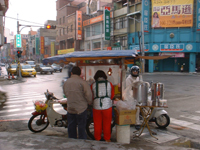
新竹の風景です。朝は小さな屋台が出て通勤途中の人達が朝ご飯を買って行きます。交差点の中でもお構いなし。
周辺のホテルに泊まっている日本人チームは私も含め、一つのホテルに集合して 乗合ワンボックス車(ワーゲン)で現場に向かいます。
This is the scenery of Hsinchu. In the morning, small food stalls are set up for people on their way to work to buy breakfast. It doesn’t matter even at intersections. The Japanese team, including myself, who are staying at hotels in the area gather at one hotel and head to the site in a shared one-box vehicle (Wagen).
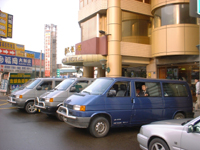
仕事先のPSC(powerchip semecondacter corp )二号館です、12インチの半導体ウェハーを 作っている工場です。
This is the second building of PSC (PowerChip Semeconductor Corp) where I work, a factory that manufactures 12-inch semiconductor wafers.
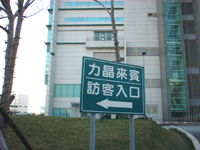
帰る時は皆元気になります。
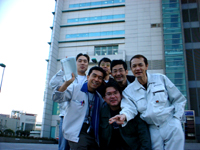
台湾の作業員も元気で帰ります。

ホテルの近くの良く行く屋台で(従業員の人達)
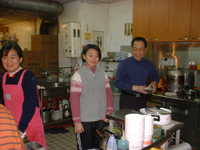

仕事場から (3月初旬)
現在、日本人25人、台湾人30人位です。現場の通訳さんは二人居ます。
台中訪問(4月中旬)
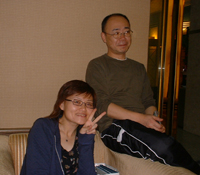
4月の中旬に台中に遊びに行きました。ホテルマンや職場の人や当時の通訳さん達と、短くも楽しい会話を 楽しむ事が出来ました。
ホテルの屋上 (4月中旬)
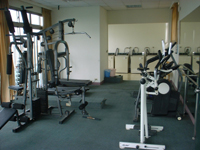
ホテルの屋上って、簡単には行けない所だと思っていましたが、今滞在中のホテルは簡単に行けます。 と言うのは、屋上トレーニングジムとランドリーがあるからです。奥にランドリーが見える。
I thought the rooftop of a hotel was a place that couldn’t be easily accessed, but the hotel I’m currently staying at is easily accessible. That’s because there is a rooftop training gym and laundry. You can see the laundry in the back.
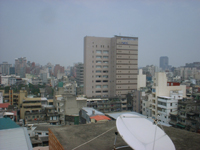
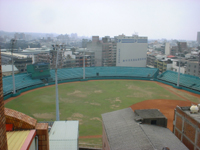
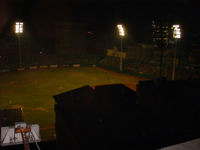
屋上からの景色です。通りの向かい には、球場があり時々ナイターも開催され応援の音がよく聞こえる。
This is the view from the rooftop. There is a baseball field across the street where night games are sometimes held and the sounds of cheering can often be heard.
star_border
夜市 (4月中旬)
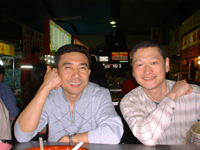
台湾は夜市が盛んです、新竹に来て初めて韓国の周さんと二人(通訳さんの案内付き)で行きました。 美味しい臭豆腐を食べました。
Night markets are popular in Taiwan, and it was my first time visiting Hsinchu with Mr. Chou from South Korea (with an interpreter to guide us). I ate some delicious stinky tofu.
散歩 (4月中旬) Walk (mid April)
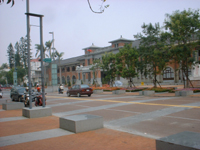
今日は日曜日、降っていた雨も上がったので駅まで散歩に出かけました。
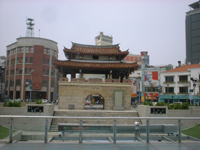
新竹市庁舎
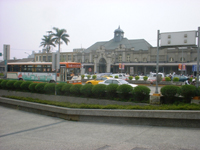
東門城と言う所
SOGOや三越があります。
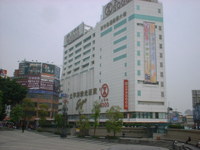

新竹駅 駅前広場で、ワンショット。
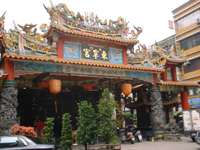
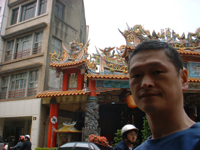
街中にこの類のお寺がチラホラあるのです。
お寺の前で一枚。
供養 (4月中旬)
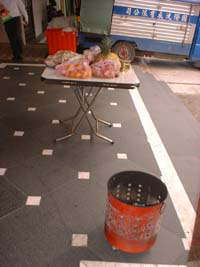
4月5日、台湾ではお墓参りの日で休日でした。先祖のお墓に参ったあと爆竹や花火を上げて供養します。 その際、紙で作ったお札(先祖様があの世で使うお金)も燃やして、天に送ります。
April 5th was a holiday in Taiwan as it was grave visiting day. After visiting the graves of our ancestors, we set off firecrackers and fireworks to offer a memorial service. At that time, paper bills (money that the ancestors will use in the afterlife) are also burned and sent to heaven.

ホテルでも、お供え物をして、お札を燃やしました。
秘密の興奮剤(5月)
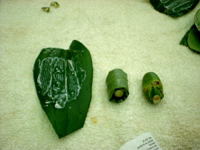
その興奮剤の名前はビンロウと言います。 ビンロウは、椰子の種類の木から取れる実(ドングリに大きさ形が似ている) に石灰系の薬品(?)を加えて、何とかという別の植物の葉で包み作った、台湾独特の趣向品です。
麻薬では無いようですが、眠気がとんだりするので長距離トラックの運転手なども愛用するらしいです。 一種の興奮剤のようです。街の中、特に道路沿いにはビンロウとタバコを売る小さな小屋が 多く在ります。
The name of the stimulant is betel nut. Betel nut is a uniquely Taiwanese fruit made by adding a lime-based chemical (?) to the fruit of a palm tree (similar in size and shape to an acorn) and wrapping it in the leaves of a different plant. It is a product. Although it doesn’t seem to be a drug, it is said to be used by long-distance truck drivers because it makes you sleepy. It’s like some kind of stimulant. There are many small huts selling betel nut and tobacco in the city, especially along the roads.

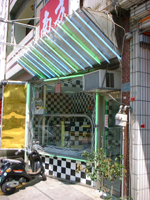
その小屋はガラス張りでピンクや紫、ブルー系のイルミネーションに輝き、 売り子さんは若くて可愛い子系の女性が、殿方の好む悩ましいスタイルで店番していて、 客の車が停まると駆け寄ってきてビンロウを売るのです。
The hut is made of glass and shines with pink, purple, and blue illuminations, and the salesperson is a young, cute woman who looks after the shop in a troublesome style that the gentleman likes, and when a customer’s car stops, she runs up and sells betel nuts. to sell.
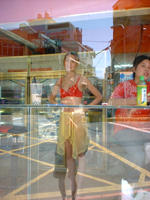
1箱50元(180円)くらいで数個入り。食べ方は口に入れて数回噛むと、苦い果汁が出てきて 口の中がエグイ状態になる。そしたら、一緒に貰う紙コップにペッペッと吐き出す。 (必ず吐き出さなければならない)果汁と実が真っ赤になって見える、当然口の中も 真っ赤であります。私も、一噛みしましたが、二噛み目は止めて吐き出しました。 とても、マズイものです。沢山噛まなかったせいか、興奮もせず眠気も何時も通りでした。 このビンロウやり過ぎると口の癌になるとか、歯のエナメル質を侵されるとかで、 健康面ではイマイチらしいです。
One box contains several pieces for about 50 yuan (180 yen). To eat it, put it in your mouth and chew it a few times, and the bitter juice will come out and leave your mouth feeling harsh. Then, I spit it out into the paper cup I received with it. The juice and fruit (which must be spit out) appear bright red, and of course the inside of the mouth is also bright red. I took one bite, but stopped the second bite and spat it out. It’s very bad. Maybe because I didn’t chew a lot, I wasn’t excited and was sleepy all the time. Excessive use of betel nut is not good for your health, as it can cause mouth cancer and damage tooth enamel.
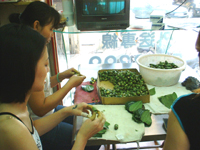

このビンロウは、年間を通して採取できるらしくお店では客待ち時間を利用して加工もしている。 山中に入るとビンロウの栽培がしてあるらしい。そのビンロウの木は直径がビール瓶ほどあり、 数メートルの高さがあり、高さの割に根を張らないので、大雨などで地滑りなどの災害の危険 もはらんでいるらしいです。
This betel nut can be harvested throughout the year, and the shop processes it while waiting for customers. It seems that betel nut is being cultivated in the mountains. The betel tree is about the same diameter as a beer bottle and several meters high, and because it does not have roots despite its height, it is said to be at risk of disasters such as landslides due to heavy rain.
初めての台湾観光(5月下旬) First trip to Taiwan (late May)
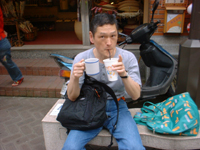
台湾に10ヶ月も居たのにホテルと職場の往復だけで、観光をした事が無かったのです。 でも、今月になってやっと観光する事が出来ました。凄く楽しかったです。
焼物の街「インクー」でジュースを飲む。右手のコップはジュースのオマケです。
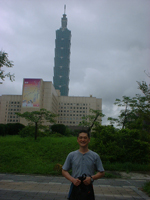

世界一のノッポビルが台北に在るんですよ。
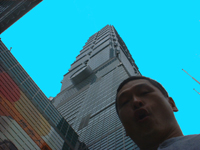
その名は 101 です。
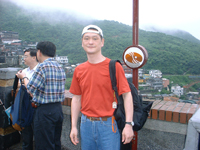
展望台まで行くのに350元。値段を見て諦めて地下レストランに入る。
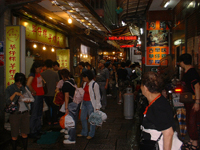
ここは、「チョウフン」というとこ。山の中腹に在る。
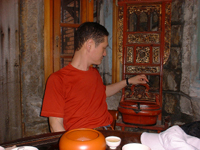
昔金が取れたらしい。今は出店が所狭しと並ぶ。
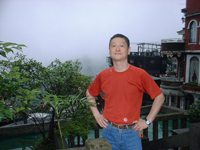
歩き疲れて、ちょっと一休み。お茶屋さんでウーロン茶を頂く。
外は雲の中、さっきまでドシャブリの雨でした。
仕事の終わり(5月下旬)
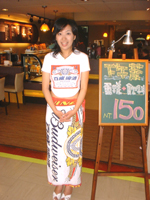
26日に仕事が終わりました。帰国の時に空港の喫茶店に台湾バドガールが居たので撮りました。 スカートが長いんですよー、ヘソは出しています。
